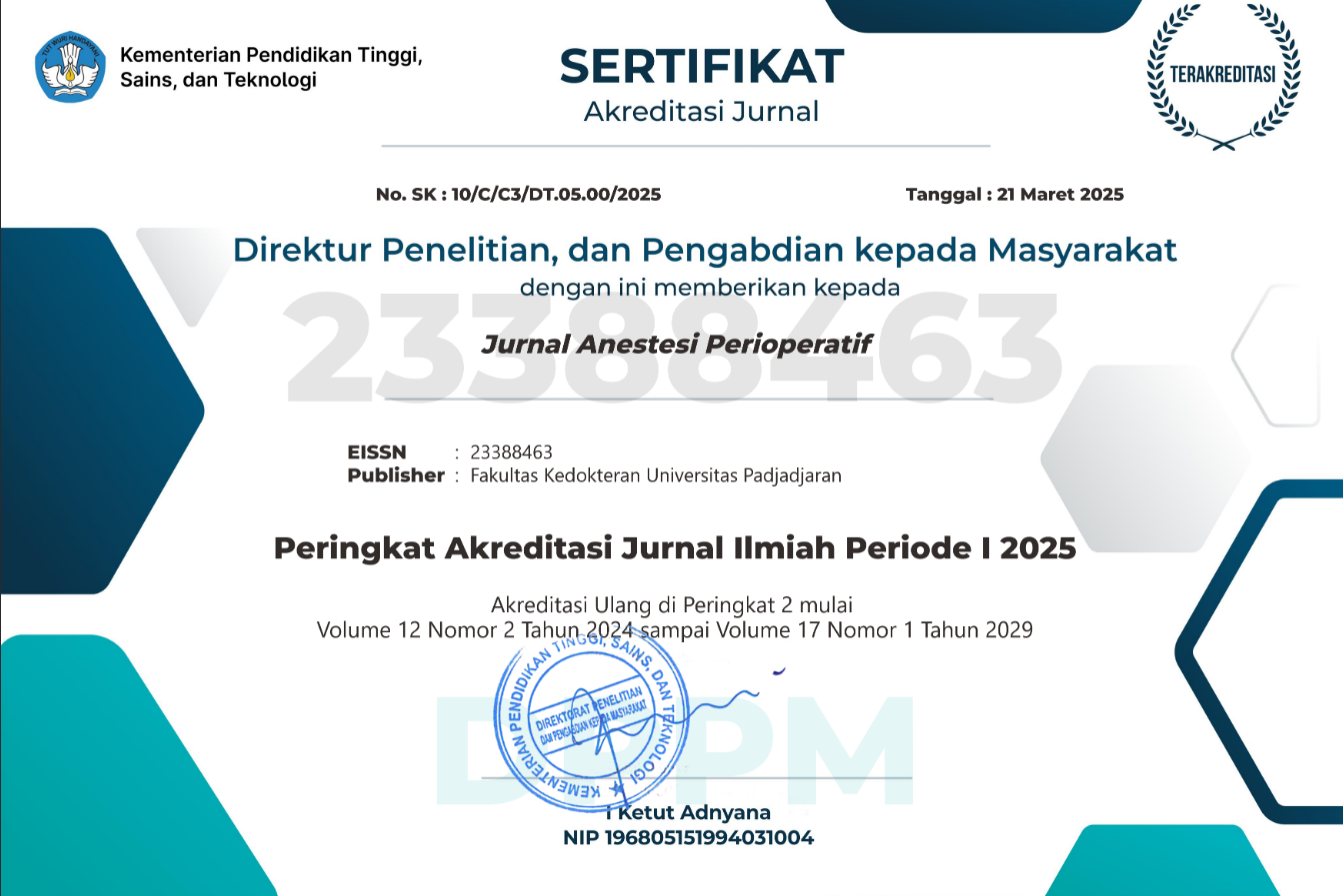Perbandingan Akurasi dan Presisi Perhitungan Resting Energy Expenditure (REE) Menggunakan Rule of Thumb, Modifikasi Harris–Benedict, dan Penn State terhadap Kalorimetri Indirek pada Pasien ICU
Abstract
Penentuan kebutuhan energi pada pasien kritis sangat penting untuk mencegah underfeeding maupun overfeeding yang dapat meningkatkan morbiditas dan mortalitas. Penelitian ini bertujuan membandingkan akurasi dan presisi tiga rumus prediktif-Harris-Benedict modifikasi (HBE × 1,25), Penn State (PSU), dan Rule of Thumb (ROT)-dengan kalorimetri indirek (IC) sebagai gold standard pada pasien ICU dengan ventilasi mekanik. Desain penelitian ini adalah observasional analitik terhadap 30 pasien di RSUP Dr. Hasan Sadikin dan RSUD Sumedang yang memenuhi kriteria inklusi. REE dihitung menggunakan ketiga rumus prediktif dan dibanding dengan hasil IC. Akurasi tertinggi diperoleh dari PSU (63,33%), diikuti ROT (46,67%) dan HBE×1,25 (30,00%) (p<0,05). Presisi tertinggi juga ditemukan pada PSU (ICC=0,713), diikuti HBE × 1,25 (0,592) dan ROT (0,462). Analisis Bland–Altman menunjukkan bias terkecil pada PSU (-81,56 kkal), dibandingkan HBE × 1,25 (-60,41 kkal) dan ROT (123,72 kkal). Simpulan, rumus PSU memiliki akurasi dan presisi terbaik dalam memperkirakan REE pada pasien kritis. Namun, pemantauan individual tetap diperlukan karena potensi bias.
Keywords
Full Text:
PDFReferences
- Delsoglio M, Achamrah N, Berger MM, Pichard C. Indirect calorimetry in clinical practice. J Clin Med. 2019(8):1387. doi: 10.3390/jcm8091387
- Moonen HPFX, Beckers KJH, Zanten ARHv. Energy expenditure and indirect calorimetry in critical illness and convalescence: current evidence and practical considerations. J Intensive Care. 2021(8):1–13. doi: 10.1186/s40560-021-00524-0
- Cordoza M, Chan L-N, Bridges E, Thompson H. Methods for estimating energy expenditure in critically ill adults. AACN Adv Crit Care. 2020;31(3):154–64. doi: 10.4037/aacnacc2020110
- Tah PC, Poh BK, Kee CC, Yii Lee Z, Rai HVR, Nor MBM, dkk. Do we need different predictive equations for the acute and late phases of critical illness? A prospective observational study with repeated indirect calorimetry measurements. Eur J Clin Nutr 2022;76:527–34. doi: 10.1038/s41430-021-00999-y
- Frankenfield DC. Factors related to the assessment of resting metabolic rate in critically ill patients. J Parenter Enteral Nutr. 2019;43(2):234–44. doi: 10.1002/jpen.1484
- Mtaweh H, Aguero MJS, Campbell M, Allard JP, Pencharz P, Pillenayegum E, dkk. Systematic review of factors associated with energy expenditure in the critically ill. Clin Nutr ESPEN. 2019;33:111–24. doi: 10.1016/j.clnesp.2019.06.009
- Tah PC, Lee Z-Y, Poh BK, Majid A, Rai H, Nor M, dkk. A single-center prospective observational study comparing resting energy expenditure in different phases of critical illness: indirect calorimetry versus predictive equations. Crit Care Med. 2020;48:e380–90
- Ndahimana D, Kim E-K. Energy requirements in critically ill patients. Clin Nutr Res 2018;7(2):81–90. doi: 10.7762/cnr.2018.7.2.81
- Murray G, MS ST, Dunlea T, Dunlea T, Jimenez AN, Eiferman D,dkk. Comparison of predictive equations and indirect calorimetry in critical care: Does the accuracy differ by body mass index classification?. Nutr Clin Pract 2023(38):1124–32. doi: 10.1002/ncp.11017
- Rousing ML, Hahn‑Pedersen MH, Andreassen S, Pielmeier U, Preiser CJ. Energy expenditure in critically ill patients estimated by population-based equations, indirect calorimetry and CO-based indirect calorimetry. Ann Intensive Care. 2016(6):16. doi: 10.1186/s13613-016-0118-8
- Lee H-J, Ahn S-B, Lee JH, Kim JY, Yoo S, Hong SK. Determining the appropriate resting energy expenditure requirement for severe trauma patients using indirect calorimetry in Korea: a retrospective observational study. J Trauma Inj. 2023;36(4):337–42. doi: 10.20408/jti.2023.0051
- Lee SJ, Lee H-J, Jung Y-J, Han M, Gyu Lee S, Hong SK. Comparison of measured energy expenditure using indirect calorimetry vs predictive equations for liver transplant recipients. J Parenter Enteral Nutr 2021;45(4):761–7. doi: 10.1002/jpen.1932
- Wu S, Iqbal S, Giroux M, Alam N, Campisi, Razek T, Deckelbaum D. Penn State equation versus indirect calorimetry for nutritional assessment in patients with traumatic brain injury. Can J Surg. 2022;65(3):E320–5. doi: 10.1503/cjs.022420
- Selvik JT, Abrahamsen EB. On the meaning of accuracy and precision in a risk analysis context. J Risk Reliability. 2017;231(2):91–100
- Menditto A, Patriarca M, Magnusson B. Understanding the meaning of accuracy,trueness and precision. Accred Qual Assur. 2006;12(1):45–7. doi:10.1007/s00769-006-0191-z
- Bendavid I, Lobo DN, Barazzoni R, Cederholm T, Coeffier M, der Schuren MDV, dkk. The centenary of the Harris Benedict equations: How to assess energy requirements best? recommendations from the ESPEN expert group. Clin Nutr 2021;40(3):690–701. doi: 10.1016/j.clnu.2020
- National Academies of Sciences E, and Medicine. Factors affecting energy expenditure and requirements. Dietary Reference Intakes for Energy. Washington, DC: The National Academies Press. 2023:50. doi: 10.17226/26818
- Chittawatanarat K. Energy expenditure in critically ill patient. Clin Crit Care 2022;30:e0019–26. doi: https://doi.org/10.54205/ccc.v30.259272
- Kim SH, Cho BH, Kim SB, Jeong JM, Yu HC. Determination of the stress factor calculated from the changes in the measured resting energy expenditure with indirect calorimetry in patients undergoing pancreaticoduodenectomy. J Clin Nutr. 2017;9(2):62–7. doi: https://doi.org/10.15747/jcn.2017.9.2.62
- McClave S, Taylor B, Martindale R., Warren MM, Johnson DR, Braunschweig, et al. Guidelines for the provision and assessment of nutrition support therapy in the adult critically ill patient:sSociety of critical care medicine (SCCM) and american society for parenteral and enteral nutrition (A.S.P.E.N.). JPEN J Parenter Enteral Nutr. 2016;40(2):159-211. doi:10.1177/0148607115621863
- Ayers P, Bobo ES, Hunt RT ASPEN Parenteral Nutrition Handbook, 3rd Edition. Silver Springs: American Society for Parenteral and Enteral Nutrition. 2020.
- Grguric L, Musillo L, DiGiacomo JC, Munnangi S. Throwing darts in ICU: how close are we in estimating energy requirements? Trauma Surg Acute Care Open 2020(5):e000493. doi: 10.1136/tsaco-2020-000493.
- Singer P, Blaser AR, Berger MM, Calder CP, Caesar M, Hiesmayr M, dkk ESPEN practical and partially revised guideline: Clinical nutrition in the intensive care unit. Clin Nutr. 2023(42):1671–89. doi: 10.1016/j.clnu.2023.07.011.
- Vasileiou G, Qian S, Iyengar R, Mulder MB, Gass LM, Parks J, dkk. Use of predictive equations for energy prescription results in inaccurate estimation in trauma patients. Nutr Clin Pract. 2020;35(5):927–32. doi: 10.1002/ncp.10372
DOI: https://doi.org/10.15851/jap.v13n1.4260
Article Metrics
Abstract view : 281 timesPDF - 95 times
This Journal indexed by

JAP is licensed under a Creative Commons Attribution-NonCommercial 4.0 International License
View My Stats



